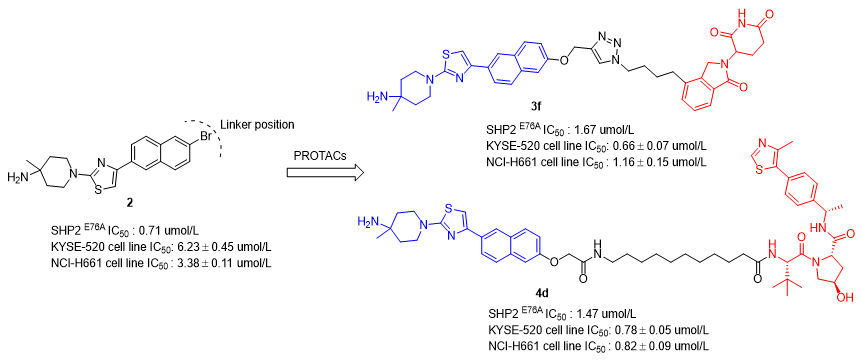| [1] |
Hof, P.; Pluskey, S.; Dhe-Paganon, S.; Eck, M. J.; Shoelson, S. E. Cell 1998, 92, 441.
pmid: 9491886
|
| [2] |
Grossmann, K. S.; Rosário, M.; Birchmeier, C.; Birchmeier, W. Adv. Cancer Res. 2010, 106, 53.
doi: 10.1016/S0065-230X(10)06002-1
pmid: 20399956
|
| [3] |
(a) Zhang, J.; Zhang, F.; Niu, R. Journal of cellular and molecular medicine 2015, 19, 2075;
doi: 10.1111/jcmm.12618
pmid: 16053901
|
|
(b) Shi, Z. Q.; Yu, D. H.; Park, M.; Marshall, M.; Feng, G. S. Mol. Cell. Biol. 2000, 20, 1526;
doi: 10.1128/MCB.20.5.1526-1536.2000
pmid: 16053901
|
|
(c) You, M.; Yu, D. H.; Feng, G. S. Mol. Cell. Biol. 1999, 19, 2416;
doi: 10.1128/MCB.19.3.2416
pmid: 16053901
|
|
(d) Wu, C. J.; O'Rourke, D. M.; Feng, G. S.; Johnson, G. R.; Wang, Q.; Greene, M. I. Oncogene 2001, 20, 6018;
doi: 10.1038/sj.onc.1204699
pmid: 16053901
|
|
(e) Tartaglia, M.; Gelb, B. D. Eur. J. Med. Genet. 2005, 48, 81;
doi: 10.1016/j.ejmg.2005.03.001
pmid: 16053901
|
|
(f) Kong, J.; Long, Y. Q. RSC Med. Chem. 2022, 13, 246.
doi: 10.1039/D1MD00386K
pmid: 16053901
|
| [4] |
Mullard, A. Nat. Rev. Drug Discov. 2018, 17, 847.
doi: 10.1038/nrd.2018.201
pmid: 30482950
|
| [5] |
(a) Araki, T.; Mohi, M. G.; Ismat, F. A.; Bronson, R. T.; Williams, I. R.; Kutok, J. L.; Yang, W.; Pao, L. I.; Gilliland, D. G.; Epstein, J. A.; Neel, B. G. Nat. Med. 2004, 10, 849;
doi: 10.1038/nm1084
pmid: 12717436
|
|
(b) Chan, R. J.; Leedy, M. B.; Munugalavadla, V.; Voorhorst, C. S.; Li, Y.; Yu, M.; Kapur, R. Blood 2005, 105, 3737;
doi: 10.1182/blood-2004-10-4002
pmid: 12717436
|
|
(c) Tartaglia, M.; Niemeyer, C. M.; Fragale, A.; Song, X.; Buechner, J.; Jung, A.; Hahlen, K.; Hasle, H.; Licht, J. D.; Gelb, B. D. Nat. Genet. 2003, 34, 148.
pmid: 12717436
|
| [6] |
Mohi, M. G.; Neel, B. G. Curr. Opin. Genet. Dev. 2007, 17, 23.
doi: 10.1016/j.gde.2006.12.011
|
| [7] |
Chan, G.; Kalaitzidis, D.; Neel, B. G. Cancer Metast. Rev. 2008, 27, 179.
doi: 10.1007/s10555-008-9126-y
|
| [8] |
(a) Chen, L.; Sung, S. S.; Yip, M. L.; Lawrence, H. R.; Ren, Y.; Guida, W. C.; Sebti, S. M.; Lawrence, N. J.; Wu, J. Mol. Pharmacol. 2006, 70, 562;
doi: 10.1124/mol.106.025536
pmid: 20170098
|
|
(b) Hellmuth, K.; Grosskopf, S.; Lum, C. T.; Wurtele, M.; Roder, N.; von Kries, J. P.; Rosario, M.; Rademann, J.; Birchmeier, W. P. Natl. Acad. Sci. USA 2008, 105, 7275;
doi: 10.1073/pnas.0710468105
pmid: 20170098
|
|
(c) Liu, W.; Yu, B.; Xu, G.; Xu, W. R.; Loh, M. L.; Tang, L. D.; Qu, C. K. J. Med. Chem. 2013, 56, 7212;
doi: 10.1021/jm400474r
pmid: 20170098
|
|
(d) Zhang, X.; He, Y.; Liu, S.; Yu, Z.; Jiang, Z. X.; Yang, Z.; Dong, Y.; Nabinger, S. C.; Wu, L.; Gunawan, A. M.; Wang, L.; Chan, R. J.; Zhang, Z. Y. J. Med. Chem. 2010, 53, 2482.
doi: 10.1021/jm901645u
pmid: 20170098
|
| [9] |
Chen, Y.-N. P.; LaMarche, M. J.; Chan, H. M.; Fekkes, P.; Garcia- Fortanet, J.; Acker, M. G.; Antonakos, B.; Chen, C. H.-T.; Chen, Z.; Cooke, V. G.; Dobson, J. R.; Deng, Z.; Fei, F.; Firestone, B.; Fodor, M.; Fridrich, C.; Gao, H.; Grunenfelder, D.; Hao, H.-X.; Jacob, J.; Ho, S.; Hsiao, K.; Kang, Z. B.; Karki, R.; Kato, M.; Larrow, J.; La Bonte, L. R.; Lenoir, F.; Liu, G.; Liu, S.; Majumdar, D.; Meyer, M. J.; Palermo, M.; Perez, L.; Pu, M.; Price, E.; Quinn, C.; Shakya, S.; Shultz, M. D.; Slisz, J.; Venkatesan, K.; Wang, P.; Warmuth, M.; Williams, S.; Yang, G.; Yuan, J.; Zhang, J.-H.; Zhu, P.; Ramsey, T.; Keen, N. J.; Sellers, W. R.; Stams, T.; Fortin, P. D. Nature 2016, 535, 148.
doi: 10.1038/nature18621
|
| [10] |
LaMarche, M. J.; Acker, M.; Argintaru, A.; Bauer, D.; Boisclair, J.; Chan, H.; Chen, C. H.-T.; Chen, Y.-N.; Chen, Z.; Deng, Z.; Dore, M.; Dunstan, D.; Fan, J.; Fekkes, P.; Firestone, B.; Fodor, M.; Garcia-Fortanet, J.; Fortin, P. D.; Fridrich, C.; Giraldes, J.; Glick, M.; Grunenfelder, D.; Hao, H.-X.; Hentemann, M.; Ho, S.; Jouk, A.; Kang, Z. B.; Karki, R.; Kato, M.; Keen, N.; Koenig, R.; LaBonte, L. R.; Larrow, J.; Liu, G.; Liu, S.; Majumdar, D.; Mathieu, S.; Meyer, M. J.; Mohseni, M.; Ntaganda, R.; Palermo, M.; Perez, L.; Pu, M.; Ramsey, T.; Reilly, J.; Sarver, P.; Sellers, W. R.; Sendzik, M.; Shultz, M. D.; Slisz, J.; Slocum, K.; Smith, T.; Spence, S.; Stams, T.; Straub, C.; Tamez, V.,Jr.; Toure, B.-B.; Towler, C.; Wang, P.; Wang, H.; Williams, S. L.; Yang, F.; Yu, B.; Zhang, J.-H.; Zhu, S. J. Med. Chem. 2020, 63, 13578.
doi: 10.1021/acs.jmedchem.0c01170
|
| [11] |
Dose Finding Study of TNO155 in Adult Patients With Advanced Solid Tumors. https://www.clinicaltrials.gov/ct2/show/NCT03114319?cond=SHP2
|
| [12] |
Huang, X.; Dixit, V. M. Cell Res. 2016, 26, 484.
doi: 10.1038/cr.2016.31
|
| [13] |
Wang, M.; Lu, J.; Wang, M.; Yang, C. Y.; Wang, S. J. Med. Chem. 2020, 63, 7510.
doi: 10.1021/acs.jmedchem.0c00471
|
| [14] |
Song, Y. H.; Yang, X. Y.; Wang, S.; Zhao, M.; Yu, B. Med. Res. Rev. 2022, 42, 1781.
doi: 10.1002/med.v42.5
|
| [15] |
Xie, J.; Si, X.; Gu, S.; Wang, M.; Shen, J.; Li, H.; Shen, J.; Li, D.; Fang, Y.; Liu, C.; Zhu, J. J. Med. Chem. 2017, 60, 10205.
doi: 10.1021/acs.jmedchem.7b01520
|
| [16] |
Ishoey, M.; Chorn, S.; Singh, N.; Jaeger, M. G.; Brand, M.; Paulk, J.; Bauer, S.; Erb, M. A.; Parapatics, K.; Müller, A. C.; Bennett, K. L.; Ecker, G. F.; Bradner, J. E.; Winter, G. E. ACS Chem. Biol. 2018, 13, 553.
doi: 10.1021/acschembio.7b00969
pmid: 29356495
|
 ), 龙亚秋a,*(
), 龙亚秋a,*( )
)
 ), Ya-Qiu Longa(
), Ya-Qiu Longa( )
)
